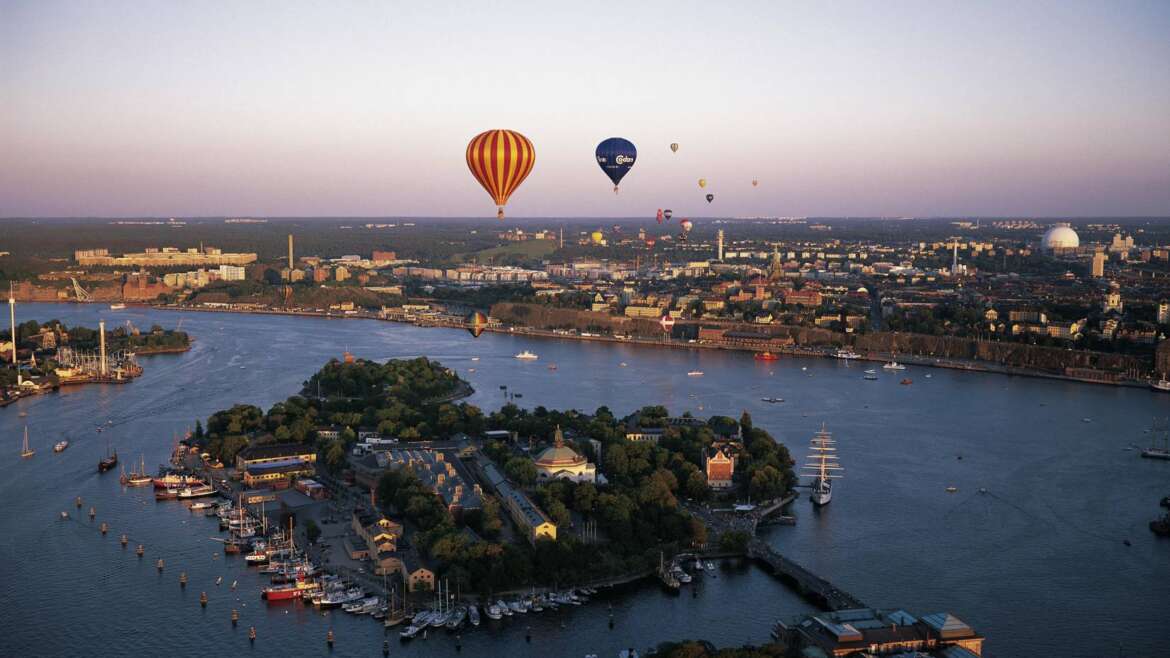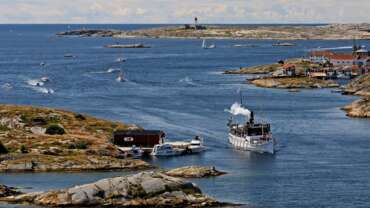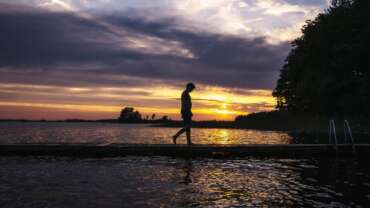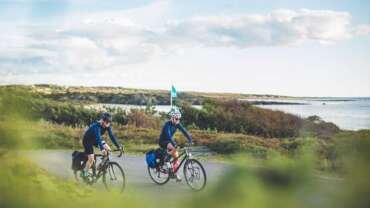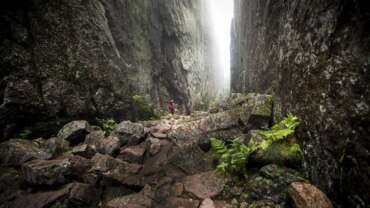Middle Sweden
Central Sweden is home to capital city Stockholm, the provinces of Dalarna and Värmland, as well as the beautiful city of Uppsala.
DALARNA
The magic is in the hands
Tord Agge is concerned. A “frost” has gotten into the pattern Morfars trädgård (Grandpa’s garden). A frost is a small misalignment, a millimeter or so, that shows when all the colours in a pattern are printed. It may be that the template ended up slightly out of place on the printing table.
Morfars trädgård consists of twelve textile colours, all hand mixed by mixing master Jesper Jobs. He runs Jobs Handtryck along with his wife Åsa. “I’ll have to look into that next time we print,” Tord Agge says, sending a thoughtful gaze out over lake Siljan just outside his window.
As he stands between two 30-meter long printing tables with his side fringe and his thick-rimmed glasses, Tord could easily be a character in the TV show Portlandia. The sturdy tables were built by Jesper’s father Peer Jobs in 1944. Peer founded Jobs Handtryck in Västanvik, near Leksand in that same year. His sisters Gocken and Lisbet drew the patterns. Colourful, optimistic and clearly sprung from the Swedish soil; rhubarb stalks, elderflower and thistles. When WWII ended and Europe breathed a sigh of relief, the textile print shop in Dalarna was an instant success.
And while other textile print workshops have turned to more industrial manufacturing, more digital processing, Jobs Handtryck remains essentially where it started in 1944. They take on a new pattern about once a decade; developing the colors and building the templates is expensive.
“We can’t follow trends. We are slow and must be so. We do know which trends are developing, but there is simply not the time to follow them,” Åsa explains.
The home of Carl and Karin Larsson, Dalarna
This colourful artist couple’s house is perhaps Sweden’s most famous home and has become an icon for Swedish interior design.
The artist couple Carl and Karin Larsson decorated their home Lilla Hyttnäs with a personal take on arts and crafts. Immortalized in the watercolor paintings by Carl Larsson, the artistic power couple’s light, colorful style has had an iconic impact on Swedish interior design and family life since the late 19th century. Lilla Hyttnäs, located in the idyllic village Sundborn, is open all year.
STOCKHOLM
Discover Stockholm’s Food And Culture
Do you boast of taste buds, both seasoned and brave? Count on Stockholm to tantalise your palate and take you by surprise! The city’s food culture is a concoction of some of the most loved global delicacies and a variety of traditional and local dishes. The fresh sea trout and salmon from the Baltic sea is something you can only crave for in other European cities.
Explore Stockholm’s History & Music scene
It’s not often that is a city can claim to be the ace of spades when it comes to boasting a glorious music scene and an even greater history. Stockholm doesn’t have to. The city which was once ruled by Vikings and Warships, melodically passed on the torch to numerous modern day pop stars. Home to renowned artists like Avicii, Swedish House Mafia and metal bands like Opeth, the city is a wonderland for audiophiles, with numerous summer music concerts and outdoor gigs taking place frequently.
Stockholm: A hub for art & design
Is there some love for art designed inside your heart? If so, Stockholm is bound to get it pulsating with its numerous globally renowned museums and exquisite designs that can be found on every nook of the city. The city is known for its minimal designs with clean and simple lines. Be it architecture, fashion or anything else, the emphasis on functionality maintains a simplistic yet charming Scandinavian aesthetic.
Experiencing Stockholm’s Nature
A city bound to coddle those who love being embraced by mother nature’s arms. Unlike other European cities, Stockholm portrays an enchanting affair between the pure waters, bare cliffs and the stretch of green across the fourteen islands. The beauty of Stockholm’s lakefront beaches, combined with activities such as pedalling on nature trails and kayaking in the archipelagos, make the city worth visiting.
Technology And Lifestyle in Stockholm
Ever wondered that a country of just 10 million people could be the birthplace of tech giants such as Spotify, Skype or Truecaller? That’s Stockholm for the world. A city that is no stranger to pulling off such phenomenal feats. The Nordic Silicon Valley is a great fit for geeks and adventurers alike. Home to the famed Stockholm Tech Week, the city’s diverse offerings and progressive lifestyle make it one of the most welcoming places to visit.
The Museum of spirits and restaurant, Stockholm
A museum about Swedes’ relationship to spirits? Yes, but the Museum of Spirits is much more than that – there are interesting exhibitions throughout the year and a restaurant serving craft drinks and outstanding food.
The Museum of Spirits is situated on the island of Djurgården. The exhibitions draw both from the history of drinking and art. The collections include some 850 commissioned works by artists such as Andy Warhol, Damien Hirst and Louise Bourgeois for Absolut Vodka, the vodka brand formerly owned by the Swedish state. The waterfront restaurant has been named one of the premier museum restaurants in the world.
SORMLAND
Hiking the Sörmland Trail (Sörmlandsleden)
The Sörmland trail, or Sörmlandsleden, is more than 1000 kilometers long and one of the longest hiking trails in Scandinavia, with many starting points easily accessible by public transport from Stockholm city.
The trail winds through a breath-taking, varied landscape with forests, open landscapes, lakes and coastline. The area surrounding the trail is largely uninhabited, but if you’re lucky you might notice wild animals such as moose or deer keeping you company along the way. Furthermore, there are several historical monuments and nature reserves to explore throughout the trail. Why not pack a tent and stay overnight? Falling asleep under the stars is a memorable experience and you can start your day with a refreshing dip in one of the lakes. If you prefer a softer adventure, the trail is divided into more than 90 sections, ranging between 2 and 21 kilometers, meaning that you adapt the length of the hike depending on how long you’re prepared to walk.
She who controls the furnace
Just before Christmas glassblower Ebba von Wachenfeldt saw a wolf trotting through the snow covered fields outside her house. “We followed it for a bit. The tracks were enormous.”
Now, a few months later, Ebba stands gazing at the same field. There is no wolf. The loud, constant humming of the furnace in the corner of the work shop is the glassblower’s ever present background noise. Ebba von Wachenfeldt’s two colleagues rattle around with their pliers and blowpipes. Glass, as a material, is silent, elegant and malleable – all the tools used to master the material are hard, heavy and dirty.
We meet up in a former schoolbuilding outside Gnesta, in the province of Södermanland. This has been Ebba’s home and workshop for twelve years.
The oldest building, dating from the early 20th century, houses her exhibition area. The newer, 1960’s school building is her workplace and shop. Generous windows allow sunlight to flow freely through her rooms. There is ample space for a warehouse, storage and a studio. But what made Ebba fall for the building at first was something rather unexpected:
“All the electricity! There is soo much here – 200 amps! We only need 60, and even that is hard to come by in ordinary houses.”
She and her husband, an IT-consultant, took possession of the premises and renamed them Skeppsta Hytta. The broadband is useless. The electrical capacity, on the other hand, is wonderfully over sized.
UPPLAND
Uppsala
Uppsala, Sweden, bridges the gap between academia and modern innovation. This vibrant university town has many strings to its historically significant bow.
Known as the Cambridge of Sweden, Uppsala is a vibrant university town located a little north of Stockholm, a mere 35-minute train ride away. Students from across Sweden – and the rest of the world – swell the term-time population of the city, giving it a youthful, international feel. (About 20% of its residents are students).
Many a Swede chooses to live in Uppsala, even if they work in Stockholm. And it’s easy to see why – the city is manageable in size yet has a lot to offer. Historically significant, centuries-old sights stud the townscape and its surroundings. No trip to Uppsala is complete without getting to know its former resident Carl Linnaeus, one of the world’s most notable botanists and scientists. He’s left plenty of marks – floral and otherwise – across Sweden and beyond.
Fast-forward to the present day, Uppsala is considered a key innovation city in which academia and a distinct business culture unite to create a fertile breeding ground for new ideas. Pharmaceutical giant Pharmacia has been headquartered here since 1951. And Maria Strømme – Sweden’s youngest ever professor of technology – founded nano technology innovation Upsalite here.
Historic Uppsala – travel back in time to the Iron Age and the Viking era
Wherever you set foot in Uppsala, you’re bound to stumble upon sights of historical significance. On display within the centrally located Carolina Rediviva, Uppsala University’s library, you’ll find the astonishing 6th century Silver Bible, one of the world’s oldest and most extensive Gothic codices. A stone’s throw away lies Uppsala Cathedral, the burial place of Swedish royals such as King Gustav Vasa, who died in 1560. Other must-see sights include Uppsala Castle and its expansive grounds. A sprawling affair, this key landmark houses three museums: Uppsala Art Museum, House of Peace and Vasaborgen. Don’t miss the opportunity to view the cityscape from high above by joining a guided walk atop the castle roof.
Uppsala University, founded in the 15th century and the oldest university in Sweden, is another draw. The building – bearing the delightfully fancy name Gustavianum – dates back to the 1620s. Even non-students can discover its legacy as it now serves as a museum. Among its highlights, you’ll find the intricately constructed Augsburg Art Cabinet, a fine example of early 17th-century cabinetmaking. Gustavianum also houses a significant portion of Uppsala University’s heritage in the shape of artworks and archaeological finds, both Nordic and classical.
Wander in Swedish botanist Carl Linnaeus’ footsteps
Set some time aside to get to know the 18th-century botanist Carl Linnaeus. The beautiful gardens, historic buildings and excursion trails he’s left behind will give you a good grasp of his work and legacy.
Linnaeus’ Hammarby is the late botanist’s floral haven. A wonderful summertime destination (open May-September), it’s located less than 15 km from the town centre (easily accessible by bike or public transport). Hammarby is home to 40 ‘Linnaean plants’, or their direct descendants, making it the largest collection of his plants anywhere in the world.
What used to be Linnaeus’ garden has now been transformed into a beautiful park, housing a wide array of exotic plants, including the Siberian apple tree that still proudly stands guard in the courtyard. The house itself is one of the best-preserved farms of the 18th century, and, fittingly, some rooms feature walls adorned with blooms and greenery.
Enjoy a meal in the city centre or dine on fresh produce in the stunning countryside
Whatever type of cuisine you happen to fancy, you’ll be able to find it in Uppsala. The restaurant at boutique hotel ‘Villa Anna’ is renowned and award-winning for a reason. The menu is based on locally sourced ingredients (often organic) and while the chefs base their menu on Swedish classics and Nordic cuisine, they take influence from both the Italian and French kitchen, making for memorable dishes. And there are plenty of highly regarded restaurants to discover slightly further afield.
Uppsala & Sigtuna
Uppsala and Sigtuna lie just north of Stockholm and make for a perfect day trip or longer stay.
Uppsala
So, what to do and see in the university city of Uppsala? Kick off with a visit to part medieval, part Gothic Uppsala Domkyrka, or Uppsala Cathedral. Inaugurated in 1435, Gothic re-styled in the 19th century, it is a must see/do in Uppsala.
Gamla (Old) Uppsala, just north of the city, boasts impressive 6th century burial mounds and in its museum you can learn about the legend of the Svea kings and gory human sacrifices (kids love this bit). Go here for Gamla Uppsala Museum, Odinsborg restaurant and Disagården open-air museum.
Carl von Linné
Another ‘must’ in Uppsala is Carl von Linné, Sweden’s greatest ever scientist and father of modern taxonomy. He lived and worked in Uppsala in the 18th century and there are museums, gardens, parks etc dedicated to his memory in Uppsala. Go here for absolutely everything Carl von Linné.
If the kids start dragging their feet, hit the nearest café and treat them to a Swedish classic of pancakes with whipped cream and jam. And then let them loose at Fyrishov Water Park. In addition to its historical charms, Uppsala is Sweden’s fourth largest city with a good range of shops, restaurants and cafés.
Sigtuna
The town of Sigtuna? Quaint? The place is a complete charm-fest and Sweden’s first town (founded in AD 980).
Sigtuna hugs the northern shores of Lake Mälaren and its cobblestone streets are arteries of the almost 1,000 year-old Stora gatan, or main street, with clusters of shops selling Swedish fashion, design and handicrafts.
For the low down on Sigtuna’s history visit Sigtuna Museum for its brilliant exhibitions and displays. For some ancient Viking detective work, pop into the museum or Tourist Office on Stora gatan and ask or a futhark, or key. This will help you unlock the mysteries of the town’s more than 150 rune stones. Careful how you pronounce futhark though.
VARMLAND – A LAKE RICH HEAVEN OF NATURAL BEAUTY
The Alma Löv Museum of Unexp. Art
For a different art experience, visit the Alma Löv Museum, located in the forests of Värmland.
The Alma Löv Museum is a contemporary art museum in the deep forests of Värmland, consisting of a central exhibition hall and ten surrounding pavilions. This low-budget project, with high artistic ambitions, was founded by artist Marc Broos in 1998 and is today run by his daughter Stella Broos. There is also a theatre and a café, open in the summer time.
NARKE
A Pile of Art, Kumla
A Pile of Art is exactly what the name indicates. Beautifully located on a hill, this sculpture park showcases some thirty sculptures with widespread forest, meadow and lakes as backdrops.
Rising 100 meters above the plains outside the town of Kumla, the Kvarntorp Pile is hard to miss. The manmade hill consists of ash remains from the shale oil recovery that took place here 1940–1966. It might sound like an unlikely place for art – nonetheless, this is one of Sweden’s most outstanding sculpture areas. Every year a new work is added to the 30 that are already spread out atop the pile.



